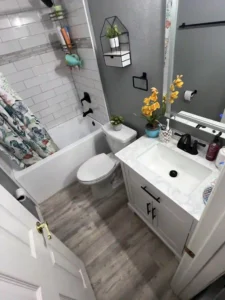
Image by Shisuka on Canva
Home renovations can be both exciting and overwhelming, especially if you’re not sure where to start. A well-structured home renovation checklist can be your best friend throughout this journey, helping you stay organized and on track. Whether you’re updating a single room or tackling a whole-house renovation, having a clear plan is essential.
From setting a budget and gathering design inspiration to hiring professionals and managing the construction process, each step requires careful consideration. In this guide, we’ll walk you through a step-by-step approach to ensure your renovation is successful, stress-free, and yields the beautiful results you’ve envisioned.
Home Renovation Checklist
There are many aspects to consider when planning a home renovation. A thorough checklist can help you stay organized and ensure you don’t miss any critical steps. Here are the top eight items to focus on:
✔Set a budget
✔Research and gather inspiration
✔Create a detailed plan
✔Obtain necessary permits
✔Hire a contractor
✔Purchase materials
✔Schedule the renovation timeline
✔Arrange temporary living accommodations if needed
Step-by-Step Guide for Your Home Renovation
Renovating your home can be a rewarding yet challenging process. To ensure a smooth and successful renovation, it’s essential to plan meticulously and follow each step carefully. Here’s a step-by-step guide to help you navigate through your home renovation project.
Planning and Budgeting
Renovating starts with detailed planning and budgeting. Begin by listing all the areas you want to renovate and estimate the costs involved. Set a realistic budget and include a contingency fund for unexpected expenses. Research materials, labor costs, and timelines to create a comprehensive plan. This stage sets the foundation for the whole project, ensuring you have a clear vision and financial roadmap.
Design and Inspiration
Renovating involves gathering design ideas and inspiration. Look for design styles that appeal to you and fit your home’s architecture. Use magazines, websites, and social media platforms like Pinterest for ideas. Create a mood board to visualize your desired look. Consult with an interior designer, if needed, to refine your vision. This step helps you establish a cohesive design plan that guides all renovation decisions.
Hiring Professionals
Renovating requires the expertise of professionals. Start by researching and hiring reputable contractors, architects, and designers. Check references, read reviews, and verify credentials. Get multiple quotes and ensure all parties understand your vision and budget. Sign detailed contracts outlining the scope of work, timelines, and payment schedules. Professional guidance ensures quality workmanship and adherence to building codes.
Obtaining Permits
Renovating often necessitates obtaining permits. Check local regulations and determine which permits are required for your project. Submit applications and necessary documents to the appropriate authorities. Permits ensure your renovation complies with safety standards and building codes. Failure to obtain permits can lead to fines, delays, and complications during the sale of your home.
Demolition and Prep Work
Renovating involves demolition and preparation. Clear out the renovation area and protect other parts of your home from dust and debris. Hire professionals for demolition to ensure safety and proper disposal of materials. Address any structural issues and prepare the site for new construction. This step sets the stage for the building and ensures a clean, safe work environment.
Construction and Installation
Renovating includes the construction and installation phase. This is where the actual building work happens, such as framing, electrical, plumbing, and HVAC installations. Follow your design plan and ensure regular communication with your contractor to monitor progress. Address any issues promptly to avoid delays. This phase transforms your plans into reality, bringing your renovation vision to life.
Finishing Touches
Renovating concludes with the finishing touches. This involves painting walls, installing fixtures, and adding final details like cabinetry, flooring, and lighting. Conduct a thorough inspection to ensure everything meets your standards. Address any minor adjustments or touch-ups needed. Clean the renovated area and move your belongings back in. This final step completes the transformation, leaving you with a beautifully renovated home.
Frequently Asked Questions

Image by Robert Kneschke on Canva
How do I prioritize tasks on my home renovation checklist?
Prioritizing tasks on your home renovation checklist involves identifying the most critical aspects of the project first. Start with structural and safety improvements, followed by functional upgrades like plumbing and electrical systems, and finish with aesthetic enhancements such as painting and flooring. Always consider the sequence of tasks to avoid rework and ensure a smooth workflow.
What are some common mistakes to avoid on a home renovation checklist?
Common mistakes to avoid on a home renovation checklist include underestimating the budget, neglecting necessary permits, choosing the wrong contractor, and failing to plan for delays. Additionally, skipping the design phase or making hasty decisions without thorough research can lead to costly and time-consuming errors.
How do I prepare my home and family for a renovation?
Prepare your home by designating storage areas for furniture and belongings that need to be moved. Set up temporary living spaces, if necessary, to minimize disruption. Communicate the renovation timeline and plans to your family, and establish safety protocols to keep children and pets away from work areas. Planning and clear communication help reduce stress and ensure a smoother renovation experience.
How can I ensure my renovation stays within budget?
To stay within budget, create a detailed financial plan before starting. Track all expenses meticulously and compare them against your budget regularly. Prioritize essential items and be willing to make compromises on less critical aspects. Keep a contingency fund for unexpected costs, and avoid making major changes once the project is underway.
Conclusion
A successful home renovation hinges on meticulous planning and organization. By following this home renovation checklist, you can navigate each phase with confidence, ensuring your project is completed on time and within budget. Remember to stay flexible and open to adjustments as needed to achieve the best results.
Ready to transform your home? Contact us at Miller 86 for professional home improvement services in Winter Haven, FL. Let us help you bring your renovation dreams to life.





